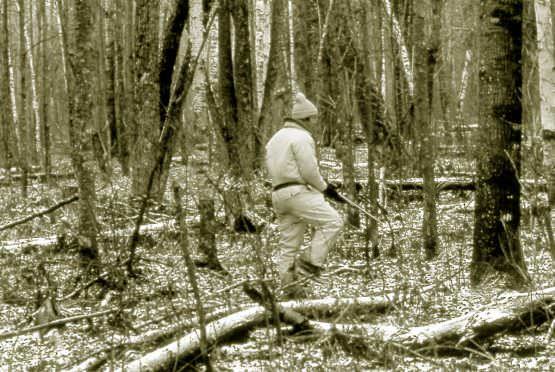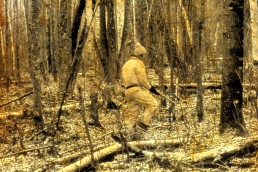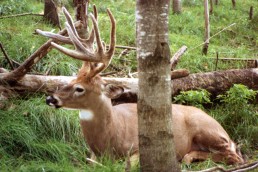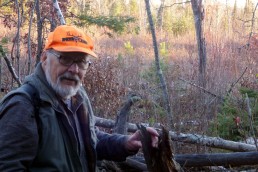Do Whitetails Consider You Dangerous?
SHARE THIS POST
You have probably already finalized your plans for hunting whitetails. That’s fine, because there is no better time than a hunting season to figure out why your favorite method doesn’t work as often as you’d like. Whereas it’s true mature whitetails are becoming more elusive, many hunters blame a lack of success on a lack of luck, i.e. failing to be at the right place at the right time. Luck likely has little to do with it—there are other reasons for failure, and some are huge, including animals recognizing danger.
Most of us dream of taking big bucks and we are rightfully pleased when it happens. During most hunts though, we often or occasionally see other deer, and hardly ever see the big bucks. We therefore conclude there aren’t many where we hunt. Actually, that’s Mother Nature’s plan, but we are nonetheless in favor of doing something to improve the number of big bucks in our hunting areas. The trouble is, big bucks won’t cooperate. These—the largest, most aggressive—three to five bucks at or near the top of their pecking orders in a 1- to 2-square-mile-area in which they live don’t allow other bucks of similar ages to inhabit the same location.

So if they are there, why do we so seldom see big bucks? It’s simple: Older bucks and does have learned to greatly fear the hunting humans, and after surviving several seasons, they’ve become very skilled at avoiding them.
Most mature bucks and does (deer living on their own after age 2) live fairly normal lives throughout hunting seasons by outmaneuvering hunters within their own individual home ranges, at least during the first days of the season. Where the need to avoid hunters is unending because of moderate to great hunting pressure primarily attributable to humans hunting deer on foot, they sensibly become nocturnal or hide on or off range in areas seldom invaded by hunting humans—swamps, posted lands, etc.—until the seasons end and after shots are no longer heard.
One thing most hunters don’t realize about mature whitetails is that they can differentiate between humans and large predators that are hunting and considered “dangerous,” and humans and large predators that aren’t hunting and are relatively harmless. Believe it or not, this ability of the whitetail is at the heart of your “lack of agreeable success” in hunting.
Whitetails in northern Minnesota are obliged to live year ‘round among great numbers of grey wolves that eagerly hunt deer. Rather than flee to safer parts of our state, like most wild prey of the predators, mature whitetails (2 1/2 years or older) here only react with alarm upon realizing wolves are near when it appears that those wolves have selected them as a prey—generally made obvious when being stalked or pursued and seeing one or more wolves suddenly halting and staring in their direction. Additionally, this is also the case when deer see wolves suddenly change course and begin moving directly toward them or when seeing or hearing a wolf sneaking toward them, often halting to sniff the air and their tracks, listening and scanning ahead. When grey wolves, the most successful deer hunters, trot steadily past mature, nearby deer and display no interest in them or their tracks and obviously are not hunting, our deer invariably freeze where they are standing or lying down, and wait. After the wolves are out of sight and out of hearing range, they resume whatever they were doing before the wolves came along: feeding, resting and chewing cud, etc. Not fleeing or taking evasive action every time a “non-hunting” wolf is near enables northern Minnesota whitetails to live less strenuous, more peaceful lives—and that’s smart.
Whitetail hunters may not look like hunting grey wolves, but we certainly act like them. Wherever deer are hunted, mature whitetails react as if humans displaying wolf-like hunting behaviors are as dangerous as the hunting grey wolves. Few things are more alarming to them than the sight of an approaching human that is sneaking, changing direction and halting to scan ahead, typical of hunters making a drive, still-hunting or attempting to stalk nearer to a deer. Quickly and noisily, or cautiously without a discernable sound, upon viewing such alarming behavior the mature whitetails (not lone fawns or yearlings) are almost certain to temporarily abandon their ranges or become nocturnal.
Like non-hunting wolves, hunters that aren’t displaying hunting behavior are treated by seen or unseen whitetails as if they are not “currently dangerous,” as long as they are safe distances away. Typically, whitetails merely watch non-hunting humans pass without becoming greatly alarmed, after which, they are unlikely to subsequently abandon their ranges or become nocturnal.
Now then, while hunting whitetails are you “currently dangerous” in appearance or “not currently dangerous?”
Are you enjoying this post?
You can be among the first to get the latest info on where to go, what to use and how to use it!
If you are a stand-hunter that is silent and patiently sitting still and as non-aggressive as a deer hunter can be, you will rarely be considered by mature whitetails to be “currently dangerous,” even by downwind deer that can identify you via airborne odors (unless discovery occurs while deer is very near). This means most mature whitetails that discover you while stand-hunting—either because your silhouette is obvious against the sky or snow, you were spotted or heard moving or you were smelled—are unlikely to abandon their ranges or become nocturnal, even though some older bucks frightened by you during previous hunting seasons may become nocturnal regardless. After discovering you stand-hunting, the deer will live normal lives within their ranges doing predictable things in typical areas during usual times, but not within sight of where you were discovered or not within what they consider to be a “safe distance” between you and most deer. Often, this happens without stand-hunters even realizing it.
To keep whitetails from abandoning their ranges and/or becoming nocturnal throughout a season, all other hunters, including your hunting partners, within one-half up to a mile of where you are stand-hunting should hunt in this same manner as well. In a single day, one aimlessly wandering hunter can ruin a buck hunt for all the others, whether stand-hunting or not, within one square mile.
Today’s mature, “stand-smart” whitetails, aided by unskilled stand-hunters, are capable of finding most in their ranges within hours after the stand-hunters begin at any site on any day or half-day. For this reason, beginning on day three of every hunting season, my hunting partners and I generally begin changing stand sites every day or half-day. (We make it a rule to sit within easy shooting range downwind or crosswind of fresh tracks made by unalarmed, mature bucks.) To remain safe from us day after day, the bucks we hunt after opening weekend must find us all over again. Sooner or later, bucks or other deer searching for us wander unknowingly into easy shooting range.
It’s difficult to carry and install portable stands in trees without alerting or alarming nearby quarries, so on day three we generally begin using our silent-to-carry-and-set-up backpacked stools to hunt at ground level, utilizing natural cover or portable blinds in a setup to remain hidden.
Finally, to preserve the great advantages when one is skilled at stand-hunting, always walk non-stop with light footsteps to and from stand sites, deliberately acting as if you or others with you are only interested in getting to a far-off destination without delay. Though you may rarely spot a mature whitetail frozen in nearby cover while doing this, rest assured, unseen deer along the way are sizing you up as you pass. If they’re not alarmed by your behavior, some of those passed deer are likely to show up near your stand site later. If any become alarmed because you’re obviously hunting as you pass, including sneaking and halting to scan ahead, you probably won’t see those deer or others, whether they’ve bounded off or just silently moved away, for the remainder of the season.
Now that you know some proven ways to improve your hunting success, consider trying them out, patiently of course, before you again suffer the consequences of convincing all or most whitetails in the area you are as dangerous as a hunting wolf.
Dr. Ken Nordberg has written more than 700 magazine articles and 12 books on the habits and hunting of whitetails and black bears, including the “Whitetail Hunter’s Almanac” series. He also produced “Doc’s Buck and Bear Hunting School” videos. His encyclopedic website is at drnordbergondeerhunting.com.
MWO
SHARE THIS POST
Did you enjoy this post?
You can be among the first to get the latest info on where to go, what to use and how to use it!
Dr. Ken Nordberg
Based on his 55 years of field research, Dr. Ken Nordberg has written more than 800 magazine articles, 12 books on whitetails—including the famous Whitetail Hunter’s Almanac series—five books on black bear hunting and produced Buck and Bear Hunting School videos. You may peruse his encyclopedic website with whitetail hunting tips: drnordbergondeerhunting.com, his blog: drnordbergondeerhunting.wordpress.com, or social media pages.



